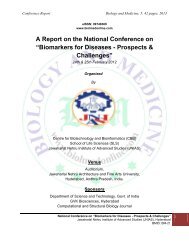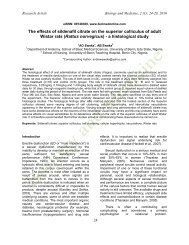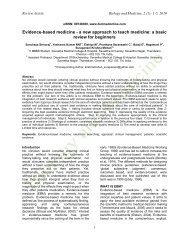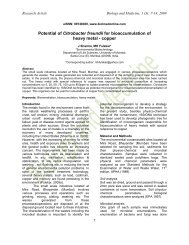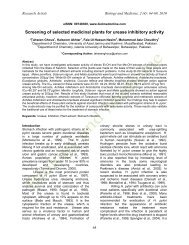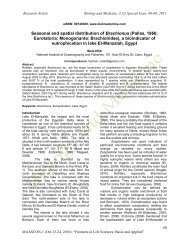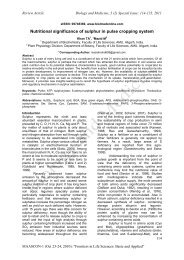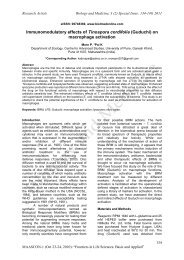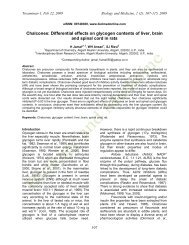Hymenoptera: Braconidae - Biology and Medicine
Hymenoptera: Braconidae - Biology and Medicine
Hymenoptera: Braconidae - Biology and Medicine
Create successful ePaper yourself
Turn your PDF publications into a flip-book with our unique Google optimized e-Paper software.
Research Article <strong>Biology</strong> <strong>and</strong> <strong>Medicine</strong>, 3 (2) Special Issue: 320-323, 2011<br />
Abstract<br />
eISSN: 09748369, www.biolmedonline.com<br />
A review of aphid parasitoids (<strong>Hymenoptera</strong>: <strong>Braconidae</strong>) of<br />
Uttar Pradesh <strong>and</strong> Uttarakh<strong>and</strong>, India<br />
*Akhtar MS 1 , Rafi U 2 , Usmani MK 2 , Dey D 1<br />
1 Division of Entomology, Indian Agricultural Research Institute, New Delhi 110012 (India).<br />
2 Department of Zoology, Aligarh Muslim University, Aligarh 202002 (India).<br />
*Corresponding Author: msakhtar123@yahoo.com<br />
A review of aphidiine parasitoids (<strong>Hymenoptera</strong>: <strong>Braconidae</strong>) associated with various aphids species occurring in<br />
Uttar Pradesh <strong>and</strong> Uttrakh<strong>and</strong>, India was compiled. The fauna of Uttar Pradesh <strong>and</strong> Uttrakh<strong>and</strong> is represented by<br />
40 species under 13 genera. This information is further reinforced with host names.<br />
Keywords: Aphid; Aphidiinae; distribution; Uttar Pradesh; Uttarakh<strong>and</strong>.<br />
Introduction<br />
Aphid pest problems are known worldwide.<br />
Most of the aphid parasitoids belong to the<br />
subfamily Aphidiinae which can be<br />
distinguished structurally by their medium body<br />
size usually about 1.5-3.5 mm long, females<br />
with short ovipositor, metasomal tergum<br />
weakly sclerotized (Achterberg, 1997).<br />
Approximately 400 species placed under 60<br />
genera have been described (Dolphine <strong>and</strong><br />
Quicke, 2001), of them 123 species under 23<br />
genera, which is around 31% of the world<br />
fauna found in India (Dey <strong>and</strong> Akhtar, 2007).<br />
This subfamily was represented by four tribes<br />
viz., Ephederini, Praini, Aphidiini <strong>and</strong> Trioxini.<br />
While analyzing the existing information, we<br />
concluded that it was absolutely necessary to<br />
bring together, summarize, check <strong>and</strong> compile<br />
all the existing information in a compact<br />
presentation. Therefore, an attempt was made<br />
to compile an inventory of Aphidiinae<br />
parasitoids associated with aphids from Uttar<br />
Pradesh <strong>and</strong> Uttrakh<strong>and</strong>.<br />
Materials <strong>and</strong> Methods<br />
Host data for Uttar Pradesh <strong>and</strong> Uttrakh<strong>and</strong><br />
records were compiled for each species. The<br />
information were collected from many primary<br />
<strong>and</strong> secondary sources of information material,<br />
both electronic <strong>and</strong> non-electronic viz., Review<br />
of Applied Entomology, CAB Pest CD,<br />
Zoological Records, Thompson Catalogue,<br />
Hymenopterorum Catalogus <strong>and</strong> various other<br />
related books, journals, bulletins, newsletters,<br />
etc. were accessed.<br />
Results <strong>and</strong> Discussion<br />
The fauna of Uttar Pradesh <strong>and</strong> Uttrakh<strong>and</strong> is<br />
represented by 40 species under 13 genera<br />
(Table 1). Analysis of data reveals that<br />
Aphidius [12 species viz., A. absinthii Marshall,<br />
A. cingulatus Ruthe, A. colemani Viereck, A.<br />
eglanteriae Haliday, A. matricariae Haliday, A.<br />
polycostulari Das <strong>and</strong> Chakrabarti, A. qadrii<br />
(Shuja-Uddin), A. rosae Haliday, A. smithi<br />
Sharma <strong>and</strong> Subba Rao, A. staryi Das <strong>and</strong><br />
Chakrabarti, A. urticae Haliday, A.<br />
uzbekistanicus Luzhetzki] having the highest<br />
number of species followed by Binodoxys [8<br />
species viz., B. centaureae (Haliday), B.<br />
indicus (Subba Rao <strong>and</strong> Sharma), B.<br />
joshimathensis (Das <strong>and</strong> Chakrabarti), B.<br />
mackaueri (Das <strong>and</strong> Chakrabarti), B. oregama<br />
(Agarwala, Saha <strong>and</strong> Mahapatra), B. rubicola<br />
(Shuja-Uddin), B. sinensis (Mackauer), B.<br />
tomentosae (Das <strong>and</strong> Chakrabarti)]. Analysis<br />
made on the host indicated that the genus<br />
Aphis is parasitized by 7 species [Binodoxys<br />
sinensis (Mackauer), Binodoxys indicus<br />
(Subba Rao <strong>and</strong> Sharma), Lipolexis oregmae<br />
(Gahan), Ephedrus plagiator (Nees),<br />
Binodoxys rubicola (Shuja-Uddin), Aphidius<br />
colemani Viereck, Cristicaudus indicus Das<br />
<strong>and</strong> Chakrabarti] followed by genus<br />
Macrosiphum [Binodoxys joshimathensis (Das<br />
<strong>and</strong> Chakrabarti), Ephedrus lacertosus<br />
(Haliday), Aphidius rosae Haliday, Praon<br />
volucre (Haliday), Aphidius polycostulari Das<br />
<strong>and</strong> Chakrabarti, Aphidius uzbekistanicus<br />
Luzhetzki] <strong>and</strong> genus Myzus with 5 species<br />
[Aphidius staryi Das <strong>and</strong> Chakrabarti,<br />
Diaeretiella rapae (M'Intosh), Lipolexis<br />
oregmae (Gahan), Aphidius eglanteriae<br />
Haliday, Binodoxys tomentosae (Das <strong>and</strong><br />
Chakrabarti)].<br />
Acknowledgement<br />
We would like to thank Dr. V.V. Ramamurthy,<br />
Principal Investigator, Network Project on<br />
Insect Biosystematics (NPIB 21-17), Division<br />
of Entomology, Indian Agricultural Research<br />
Institute, New Delhi for providing necessary<br />
facility <strong>and</strong> Indian Council of Agricultural<br />
MAASCON-1 (Oct 23-24, 2010): “Frontiers in Life Sciences: Basic <strong>and</strong> Applied”<br />
320
Research Article <strong>Biology</strong> <strong>and</strong> <strong>Medicine</strong>, 3 (2) Special Issue: 320-323, 2011<br />
Research (ICAR), New Delhi for providing<br />
financial assistance to NPIB 21-17.<br />
References<br />
Achterberg CV, 1997. Subfamily Aphidiinae. In:<br />
Wharton, R. A., Marsh, P. M., <strong>and</strong> Sharkey, M. J.<br />
(Eds.), Manual of the New World Genera of the<br />
Family <strong>Braconidae</strong> (<strong>Hymenoptera</strong>). International<br />
Society of Hymenopterists, Washington D.C., 1:<br />
119-132.<br />
Dey D, Akhtar MS, 2007. Diversity of natural<br />
enemies of aphids belonging to Aphidiinae<br />
(<strong>Hymenoptera</strong>: <strong>Braconidae</strong>) in India. Journal of<br />
Asia-Pacific Entomology, 10: 281-296.<br />
Dolphin K, Quicke DLJ, 2001. Estimating the global<br />
species richness of an incompletely described<br />
taxon: an example using parasitoid wasps<br />
(<strong>Hymenoptera</strong>: <strong>Braconidae</strong>). Biological Journal of<br />
the Linnean Society, 73: 279-286.<br />
Table 1. A list of Aphid Parasitoids (<strong>Hymenoptera</strong>: Aphidiinae) of Uttar Pradesh <strong>and</strong><br />
Uttarakh<strong>and</strong>.<br />
S.<br />
No.<br />
Parasitoids Hosts<br />
1. Aphidius absinthii Macrosiphoniella yomogifoliae on Artemisia sp.; M.<br />
Marshall<br />
kikungshana on Artemisia sp.; M. pseudoartemisae on Artemisia<br />
vulgaris; M. sanborni on Chrysanthemum sp.; Macrosiphoniella<br />
sp. on Chrysanthemum sp.<br />
2. Aphidius cingulatus<br />
Ruthe<br />
Pterocomma sp. on Populus citiata, Salix tetrasperma<br />
3. Aphidius<br />
Viereck<br />
colemani Aphis sp. on Rumex sp.; Hyalopterus pruni on Prunus persicae<br />
4. Aphidius<br />
Myzus sorbi on Sorbaria tomentosa; Macrosiphoniella<br />
eglanteriae Haliday pseudoartemisiae on Artemisia vulgaris; Capitophorus<br />
5. Aphidius<br />
matricariae Haliday<br />
formosartemisiae on Artemisia sp.<br />
Brachycaudus helichrysi on Prunus persicae<br />
6. Aphidius<br />
Macrosiphum (Sitobion) sp. on Rosa sp.<br />
polycostulari<br />
<strong>and</strong> Chakrabarti<br />
Das<br />
7. Aphidius qadrii Brachycaudus helichrysi on Anaphalis sp.; Brachycaudus sp. on<br />
(Shuja-Uddin) Gnaphalium sp.; Capitophorus sp. on Anaphalis cinnamomea;<br />
Unidentified aphid on Artocarpus heterophyllus<br />
8. Aphidius rosae Macrosiphum (Sitobion) rosaeformis on Rosa sp.; Macrosiphum<br />
Haliday<br />
(Sitobion) rosae on Rosa sp.<br />
9. Aphidius smithi Acyrthosiphon pisum on Pisum sativum, Medicago sativa, Vicia<br />
Sharma <strong>and</strong> Subba<br />
Rao<br />
faba<br />
10. Aphidius staryi Das<br />
<strong>and</strong> Chakrabarti<br />
Myzus cornutus on Prunus cornuta<br />
11. Aphidius<br />
Haliday<br />
urticae Acyrthosiphon sp. on Euphorbia pilosa<br />
12. Aphidius<br />
Acyrthosiphon sp. on Bothriochloa sp.; Macrosiphum miscanthi<br />
uzbekistanicus on Hordeum vulgaris; Schzaphis sp. on Grass, Macrosiphum<br />
Luzhetzki<br />
(Sitobion) miscanthi; Macrosiphum (Sitobion) sp. on Avena<br />
sativa, Grass, Penisetum falccidum<br />
13. Archaphidus Greenidea ficicola on Psidium guajava; G. formosana heeri on<br />
greenideae<br />
<strong>and</strong> Schlinger<br />
Stary Syzygium guajava<br />
MAASCON-1 (Oct 23-24, 2010): “Frontiers in Life Sciences: Basic <strong>and</strong> Applied”<br />
321
Research Article <strong>Biology</strong> <strong>and</strong> <strong>Medicine</strong>, 3 (2) Special Issue: 320-323, 2011<br />
14.<br />
15.<br />
16.<br />
17.<br />
18.<br />
19.<br />
20.<br />
21.<br />
22.<br />
23.<br />
24.<br />
25.<br />
26.<br />
27.<br />
28.<br />
29.<br />
30.<br />
Betuloxys<br />
intermedius (Shuja-<br />
Uddin)<br />
Binodoxys<br />
centaureae<br />
(Haliday)<br />
Binodoxys indicus<br />
(Subba Rao <strong>and</strong><br />
Sharma)<br />
Binodoxys<br />
joshimathensis (Das<br />
<strong>and</strong> Chakrabarti)<br />
Binodoxys<br />
mackaueri (Das <strong>and</strong><br />
Chakrabarti)<br />
Binodoxys oregama<br />
(Agarwala, Saha<br />
<strong>and</strong> Mahapatra)<br />
Binodoxys rubicola<br />
(Shuja-Uddin)<br />
Binodoxys sinensis<br />
(Mackauer)<br />
Binodoxys<br />
tomentosae (Das<br />
<strong>and</strong> Chakrabarti)<br />
Cristicaudus<br />
garhwalensis, Das<br />
<strong>and</strong> Chakrabarti<br />
Cristicaudus indicus<br />
Das <strong>and</strong> Chakrabarti<br />
Diaeretiella rapae<br />
(M'Intosh)<br />
Ephedrus lacertosus<br />
(Haliday)<br />
Ephedrus laevicollis<br />
(Thomson)<br />
Ephedrus nacheri<br />
Quilis<br />
Ephedrus plagiator<br />
(Nees)<br />
Ephedrus<br />
srinagarensis Stary<br />
<strong>and</strong> Bhagat<br />
Capitophorus formosartemisiae on Artemisia vulgaris,<br />
Artemisia sp<br />
Senecio sp.<br />
Aphis craccivora on Solanum nigrum; A. gossypii on Bidens<br />
pilosa, Capsicum sp., Cestrum nocturnom, Chrysanthemum sp.,<br />
Coccinia cardifolia, Cucumis melo, Cuscuta reflexa, Durant sp.,<br />
Gossypium herbaceum, G. hirsutum, Gynura angutosa,<br />
Hibiscus rosasinensis, Psidium guajava, Solanum melongena,<br />
Tinospora sp.; A. nerii on Calotropis procera; Aphis sp. on<br />
Solanum sp.; Brachycaudus helichrysi on Pyrus sp.<br />
Macrosiphum (Sitobion) miscanthi on Bothriochloa sp.<br />
Melanaphis meghalayensis meghalayensis on Bamboo<br />
Ceratovacuna sp.? pergl<strong>and</strong>ulosa on Grass<br />
Aphis ruborum longisetosus on Rubus ellipticus<br />
Aphis citricola <strong>and</strong> A. gossypii on Cestrum nocturnum<br />
Myzus sorbi on Sorbaria tomentosa<br />
Capitophorus formosartemisiae on Artimisia vestita<br />
Aphis sp. on Glochoin<br />
Brachycaudus helichrysi on Prunus amygdalus; Brevicoryne<br />
brassicae on Raphanus sativus; Hayhurstia atriplicis on<br />
Chenopodium album; Lipaphis erysimi on Brassica campestris<br />
var. cauliflower, Mustard; Metopolophium (Metopolophium)<br />
dirhodum; Myzus persicae<br />
Macrosiphum (Sitobion) miscanthi; Takecallis himalayensis on<br />
Bamboo<br />
Cavariella aegopodii on Salix hastate<br />
Hayhurstia atriplicis on Chenopodium album; Melanaphis<br />
arundinariae on Pyrus pashia<br />
Aphis fabae on Tagetes erecta<br />
Prociphilus sp. on Lonicera quinquelocularis; Unidentified<br />
aphids on Cotoneaster sp.<br />
MAASCON-1 (Oct 23-24, 2010): “Frontiers in Life Sciences: Basic <strong>and</strong> Applied”<br />
322
Research Article <strong>Biology</strong> <strong>and</strong> <strong>Medicine</strong>, 3 (2) Special Issue: 320-323, 2011<br />
31.<br />
32.<br />
33.<br />
34.<br />
35.<br />
36.<br />
37.<br />
38.<br />
39.<br />
40.<br />
Kashmiria aphidis<br />
Stary <strong>and</strong> Bhagat<br />
Lipolexis oregmae<br />
(Gahan)<br />
Lysiphlebia mirzai<br />
Shuja-Uddin<br />
Lysiphlebus<br />
delhiensis (Subba<br />
Rao <strong>and</strong> Sharma)<br />
Pauesia lachniella<br />
Das <strong>and</strong> Chakrabarti<br />
Pauesia orientalis<br />
Das <strong>and</strong> Chakrabarti<br />
Praon himalayensis<br />
Das <strong>and</strong> Chakrabarti<br />
Praon orientale<br />
Stary <strong>and</strong> Schlinger<br />
Praon pubescens<br />
Stary<br />
Praon volucre<br />
(Haliday)<br />
Prociphilus sp. on Lonicera quinquelocularis<br />
Aphis craccivora on Benincasa hispida, Cassia fistula; A.<br />
gossypii on Rumex sp.; A. nasturtii on Luffa cylindrical,<br />
Tectona gr<strong>and</strong>is; Myzus persicae on Capsicum frutescens,<br />
Solanum melongena<br />
Hyalopterus pruni on Phragmites kerke; Longiungus sacchari<br />
on Sugarcane; Melanaphis sacchari on Pennisetum glaucum,<br />
Saccharum officinarum, Sorghum bicolor, Zea mayz,<br />
Rhopalosiphum maidis on Pennisetum glaucum, Triticum<br />
aestivum, Zea mays; Schizaphis graminum on Penninsetum<br />
glaucum, Zea mays<br />
Melanaphis sp. on Grass; Rhopalosiphum maidis on Pennisetum<br />
glaucum, Triticum aestivum, Zea mays; Schizaphis graminum<br />
on Pennisetum glaucum, Zea mays<br />
Lachnus tropicalis on Quercus dealbata<br />
Cinara maculipes on Pinus excelsa<br />
Callaphis jugl<strong>and</strong>is on Juglans regia<br />
Uroleucon sp. on Sanchus aevensis <strong>and</strong> Sanchus sp.<br />
Nasonovia sp. on Sitobilanthes sp.<br />
Macrosiphum (Sitobion) sp. on Rosa sp.<br />
MAASCON-1 (Oct 23-24, 2010): “Frontiers in Life Sciences: Basic <strong>and</strong> Applied”<br />
323




